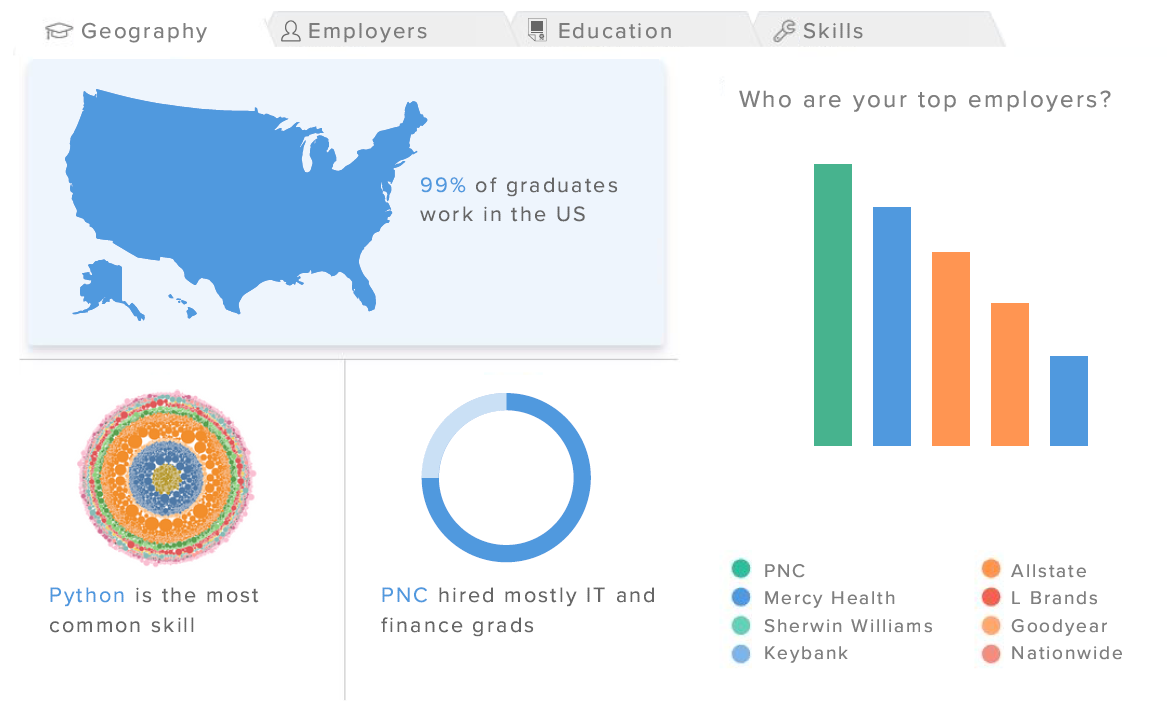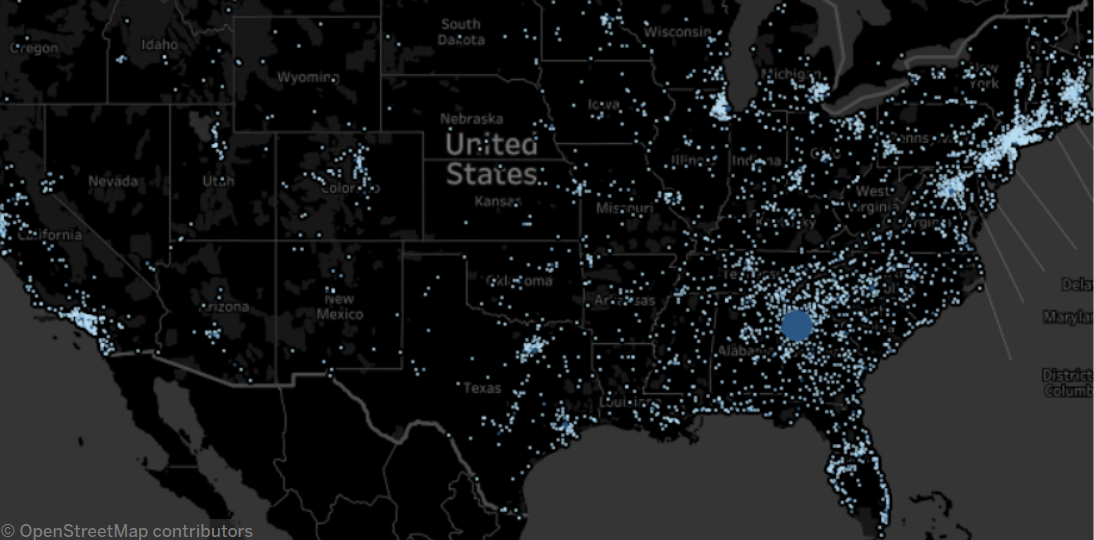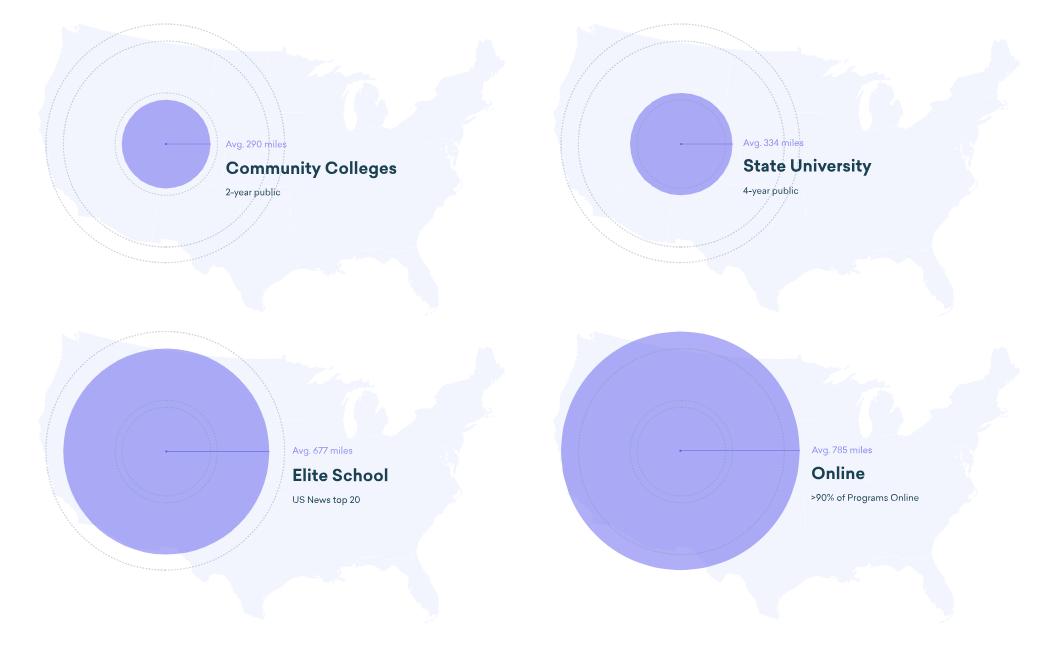
Where are your alumni now?
How disruptive innovation can reverse the internal data divide
Written by Erin Pearson

How disruptive innovation can reverse the internal data divide
Written by Erin Pearson
Where are your alumni now?
If donors, partners or prospective students pose this question to your school, how would you respond?
It depends on who you work for. The decentralization of institutional research gives unprecedented access to graduate insights and outcomes at all university levels by translating data into meaningful, coherent stories. A side affect of this unfolds as the fundamental value of the alumni survey shrinks as data solutions grow.
But how relevant is this concept for your university? As the age of big data becomes increasingly attached to the value of higher education, evaluating its current role and the impact on both internal and external communication is paramount to the performance of your school as a whole.
Why?
Because data tells the untold story of your growing alumni network.
The core of your mission is student success. And being able to tell this story in a way every audience finds value is impossible without having a robust knowledge base to source from. Incomplete data sets result in stories with holes, and this leads to programs that fail. Universities are under increasing scrutiny to provide transparent and accurate graduate insights and outcomes for students, legislators and their peers.
Here’s where graduate insights hold serious weight. They are critical in communicating not only the narrative of your students but the narrative of impact you've had on them. If your college-ready students are ready for the workforce, your network wants to know.

Steppingblocks Graduate Insights
The elements are basic. The details, however, are complex, and the deeper you go the more meaningful the results. Summarize every job, salary, degree, skill and milestone on each alumni record, and transform the trajectory of your school with unparalleled access to your alumni, through data.
Learn majors in decline to adjust course offerings and produce the most sought-after educational degrees. Guide students to opportunity with maps where alumni live, work and thrive. Discover scale and reach with geographic analysis to learn the local, regional and national impact of your alumni network. And with reliable record-level data, improve donor outreach, locate top supporters and explore new markets for development campaigns.
The future of higher education starts by making better decisions with data. So why are there so many barriers today?
Innovation is an investment. And many university offices lack the funding and freedom to choose how needs are met. If data resources are available, they’re usually stretched thin based on budgets and exhaustive requests. For universities with antiquated hierarchies, institutional research departments are burned out by this organizational model servicing top-level stakeholders with narrowly defined goals.
The Association for Institutional Research (AIR) calls for a new vision:
Institutional research once took pride in being the “one source of the truth,” yet the new role is in coaching a wide array of data consumers, managing institution-wide data and analytical requirements, and orchestrating “the economics of institutional research” in balancing information supply and demand.
Or in other words, establishing data shops at the departmental level encourages buy-in, growth and scale.
Organizational shifts in higher education, specifically related to technology, require internal training to transfer knowledge from a highly-trained staff to a broader range of experience. Disruptive innovation, according to AIR, is a necessary growing pain to develop the skills and capacity for the widespread and effective use of technology.
Especially when manual surveys are the standard.
Student surveys are not one size fits all, and response rates can vary greatly depending on collection methods, question delivery, incentives, loyalty and timing. But historically, they’ve been fundamental for unlocking graduate insights and outcomes at many universities, and more recently, NACE has promoted the First-Destination Survey as critical to the advancement of universities across the country when integrated into established assessment practices.
First-Destination Surveys narrate chapter one in the untold stories of your alumni. But here is the caveat. These surveys rely on active participation by both the student and the school. If the survey design is flawed, the response rate will reflect it. For best results, execution takes more than an email, and success relies on events, social campaigns, partnerships and freebies — translating ultimately to resource fatigue.
But when done well, First-Destination Surveys produce brilliant results. Take Princeton. Their “Class of 2017 Post-Graduation Plans Survey” resulted in a response rate of 99.8 percent.
How did they do it?
According to Handshake, Princeton requires students to complete the survey before receiving their cap and gown, requiring little extra input from the school. Platforms like Handshake offer NACE-compliant tools designed specifically to support FDS efforts.
By definition, First-Destination Surveys stop at chapter one. But what happens, 5, 10 and 20 years after graduation? Even NACE will tell you the most significant graduate outcomes occur over a lifetime.
Fill in the gaps where the first destination can’t, and make better decisions with data.
Where your alumni live and work matters.
Are they impacting the local workforce by obtaining employment nearby, or are they using their education to affect communities on a regional or national scale? This knowledge, paired with labor market insights, can change the direction of your enrollment campaigns and positively influence the public perception of your school.

Steppingblocks Geographic Analysis
On paper, your school’s geographic footprint is likely well-defined. But in practice, it may not be so clear. To shape the boundaries and share the results, a geographic analysis is key. Last year, Emsi partnered with The Wall Street Journal to publish research on where graduates move after college and which U.S. cities have the most drawing power. The data company went a step further to consider how the type of institution affects where graduates go.
They learned 61 percent of community college attendees stay within 50 miles of the school and graduates from state universities don’t travel much farther at an average of 334 miles. Elite institutions send their grads to big cities, and online educators see the fewest boundaries of all.

Emsi Research: Average migration distances for students of each type of school
Understanding geographic trends affects how you collaborate with local, regional and national partners; aids in initiatives to prevent brain drain and promote retention; and supports university-wide efforts to diversify revenue streams and pursue growth.
Where your alumni live and work matters. But if you’re struggling with unreliable contact records, you're getting left behind.
If you strive to build a sustainable culture of philanthropy among supporters, how do you maintain records over time?
At the core of every advancement team is a set of custom blueprints. These designs lay out the infrastructure for a two-way communication network between alumni and alma mater. But what happens when the connection is bad or lost? Two-way communication is inherently ineffective if only one contact is on the line.
 Consider scenario one: outdated alumni records
Consider scenario one: outdated alumni recordsFive years ago, a student graduated with a bachelor’s degree in history from University X in Atlanta. She got a job while pursuing her MBA from University Y. She moved to Charlotte two years later but never updated her records. She continues to receive invitations for history-related events in Atlanta, which she won’t advocate, attend or support. Not only is this a waste of time and resources, it’s a disservice to the student and a missed opportunity for a lifetime of giving.
There are a number of ways to obtain matched alumni data files. For front-end filtering, use a tool like our Graduate Explorer to define your objectives and generate an outreach-ready list.
Narrow by wealth to target affluent alumni for high-impact fundraising campaigns. Find veterans by location for military scholarship support. Or search by career and cohort for industry-related event invitees. This 3-step process will restore the time and money you’ve lost through manual maintenance and data collection.
.png?width=900&name=40+%20living%20in%20Atlanta%20making%20$100K%20(1).png)
The University Foundation issues a new fundraising initiative with goals that can only be met by tapping into additional markets. Your digital team launches a Facebook campaign with generic messaging to a broad audience unsegmented by age, gender or location. The results are poor and the goal is not met.
Outpace the competition and unlock your targets with advanced graduate insights for your school. Use your data to mirror top supporters, and narrow further with interest-based targeting and design.
If you know your target population is mostly men in Georgia who enjoy reading, travel and music, cut through the noise in the digital space, and send the right message, at the right time to an audience who will react.
Where do your alumni work?
Match degrees earned to top employers by cohort and region to fill in the gaps, identify opportunity and improve employer relationships. Are important companies losing interest in your school? It might be time to invite them back to engage with prospective recruits.
Take a look at the employer analysis for this institution. Hiring by State Farm has dropped with every cohort since 1990, with the exception of one. It’s up to the Employer Relations department to identify this trend, strengthen the relationship and enhance State Farm’s presence on and off campus.

Steppingblocks Employer Trend Analysis by Graduating Cohort
Unlock hiring trends with an in-depth look at the specific job roles your top employers have filled. Analyze by function and cohort for the graduate insights you need to adapt your initiatives and compete with your peers. Are alumni leaving to earn advanced degrees at other schools? Use interest-based marketing to target a meaningful population and reverse the negative trend.
Filter by education to see employers by field of study and degree. Improve your course offerings by understanding which majors are in demand and why.
If 85% of jobs that will exist in 2030 haven't been invented yet, how can your curricula keep up with demand at the skills level? This widely quoted statistic published in a report by Dell Technologies, speaks to the skills gap and the growing distance between student assets and employer expectations.
If you can't define the skills your top employers want, introduce big data to the plan.
As you dive in, visualize student success criteria with an alumni skills analysis. Research by function and popularity for advanced knowledge on how to modify programming and ultimately, performance. This college might adjust its coursework after learning SQL falls above C++ for popular programming languages.

Ask about Steppingblocks for your school, and get full-story graduate insights without the need for manual surveys. Access a dataset of over 60 million professionals, and add value to every level of your institution with the insights you need to adapt and direct your current initiatives from advancement to academic affairs.
Slice and dice over 100 attributes for custom data models designed to fit the needs of your institution — whatever they are. Your stakeholders will love our ease of reporting and your colleagues will love our support.
Data collection is the easy part. Making sense of it is hard. Until now. The future in higher education starts with Steppingblocks. Push the boundaries of education with technology today.
Research your future career with real-world stats about your major, your interests, and your job title. Turn billions of data-points into actionable insights about your future with a few simple clicks. Watch the video to find out how.
© 2025 Steppingblocks, Inc. All rights reserved